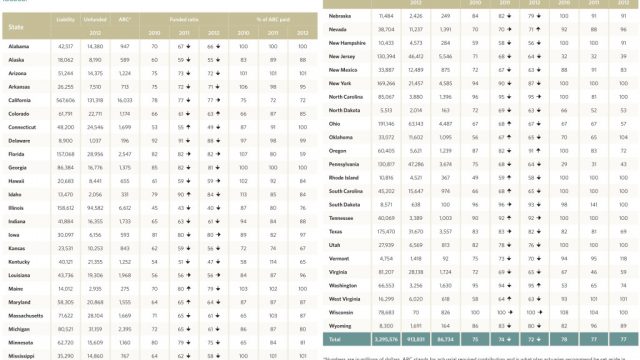Why something called an ARC is key to understanding PA’s pension mess

By Eric Boehm | PA Independent
Pennsylvania’s debt outlook remains negative because the state still underfunds its pension systems and is unlikely to fully fund them in the coming years.
Fitch’s, a credit ratings agency, gave a sobering view of Pennsylvania’s pension mess in a report Thursday that affirms the state’s AA bond rating, but warned of downgrades that could be coming in the not-too-distant future. The main reason for concern is continued efforts in Harrisburg to shortchange a pension system that’s already more than $48 billion in debt.
Even with increases in payments in coming years, the state will still fall short of those annual required contributions, Fitch’s warned.
Lawmakers in Harrisburg are drafting plans for a pension overall, but that three-letter acronym is a crucial element of any proposal.
All public pension plans come with an Actuarial Required Contribution, or ARC. The figure varies from plan-to-plan and year-to-year, but it represents a mathematical calculation of how much an employer (in this case, the employer is the state of Pennsylvania) must pay into the plan to balance the long-term investment returns and payments to beneficiaries.
In other words, it’s how much money the number crunchers say you have to put in the pot each year so there’s enough in the pot for everyone to get their pension at the end of the day — assuming investment returns hit their marks, which is a whole other issue we’ve explored before and won’t dive into here.
Putting in 100 percent of the ARC each year isn’t going to fill in the holes many states have dug for themselves over the last decade — to do that, plans have to pay more than 100 percent of the ARC, and do it for a long time — but it would be enough to keep the holes from getting much deeper.
Most states have been shortchanging their pension plans for years, under the assumption that better-than-expected investment returns would make up the difference. Pennsylvania’s been doing that too, since 2003.
But Pennsylvania lawmakers have taken shortchanging to a whole new level.
Here’s a summary from the Pew Center on the States, with percentages for the last three years to show whether states met (or in some cases, even exceeded) their ARC payments.
NEARLY THE WORST: Most states have made all or most of their annual required contributions over the last three years, but Pennsylvania hasn’t even come close.
Notice something? With the possible exception of New Jersey, no other state in the country has been as much of a deadbeat as Pennsylvania.
On average, states have contributed about 77 percent of their respective ARC payments since 2010, but Pennsylvania has put in less than 35 percent of the mandatory contributions over the same period.
Even Illinois, which has become the poster child for disastrous public sector pension policy because of its $100 billion unfunded liability, is doing better than Pennsylvania. From 2010 through 2012, Illinois paid an average of 81 percent of its ARC each year.
According to Pew, the ARC for Pennsylvania’s two major public pension plans was about $3.6 billion in 2012.
How much did the state budget for pensions that year? About $1.5 billion.
In 2010, lawmakers approved an overhaul to the state pension systems that implemented so-called “collars” on how the state would have to pay into the system. Essentially, they took the carefully calculated ARC, threw it in the trash and replaced it with their own assessment of how much money needed to be put into the pension plans for each year through 2014.
“Collars don’t save any money. They defer payments and that costs you more,” Jim McAneny, executive director of the state Public Employee Retirement Commission, a state agency that serves in an advisory role to lawmakers on pension issues, told PA Independent in February. “Pay me now or pay me later, but you’re going to end up paying me more if you pay me later.”
The collars are set to expire this year, which is one of the reasons lawmakers and the Corbett administration are scrambling to address the pension situation.
State Rep. Mike Tobash, R-??, who has been crafting a pension overhaul package designed to address Pennsylvania’s $48 billion unfunded liability, publicly released details of the plan this week. He wants to create a new class of benefits for future hires and begin transitioning the state away from the traditional public sector pension program and towards something that more closely resembles the 401(k) system used commonly in the private sector.
“Most of us are familiar with public pension systems in other parts of the United States that have faced crisis status,” said Tobash. “In Pennsylvania, our approach is to be proactive so our public employees and teachers get every dollar they have earned.”
He seems to have the tacit backing of Gov. Tom Corbett’s administration, but it’s hard to say whether that helps or hurts the bill’s chances of advancing through the Legislature.
In that outline, Tobash didn’t mention anything about the so-called “collars” currently attached to Pennsylvania’s annual pension contributions.
Lawmakers have good reason to like the collars. Putting less money in the pension system means more money for schools, state parks and their own pet projects.
But what’s good for them isn’t necessarily good for the state’s bond rating, workers who expect to get a pension when they retire or taxpayers who will have to foot the bill eventually.







